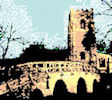The Legacy of the Railway

Station House from Uppingham Road
Today
Take any road out of Medbourne and you will encounter evidence of the railway. On Uppingham Road the chimneys of Station House stand above the parapet of the old railway bridge. On the Blaston track Leviathon Wood is bordered by a high embankment with an arched bridge and culvert in the southwest corner. Manor Road has a bridge over a deep cutting and Drayton Road has a hump-backed bridge. Along Ashley Road, immediately south of the river Welland, stands Ashley Road Station House. Slawston Road has another bridge and the single track road to Weston (Green Lane) cuts through a high embankment where the overbridge no longer has a parapet. Along Hallaton Road there are bridge piers and and the railway embankment, most noticeable where the road to Slawston cuts through a brick-arched bridge. Thus, there are railway remains on all points of the compass, only possible because multiple railway lines converged around Medbourne.
The old map below shows this clearly.
History
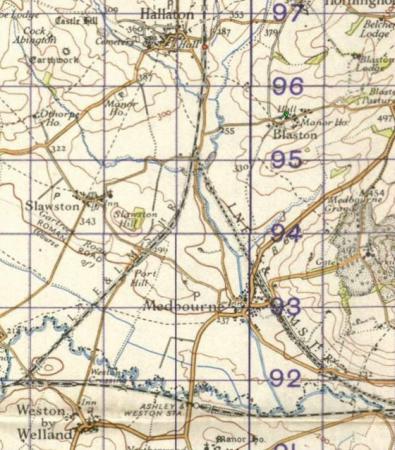
Before a railway line could be constructed it was necessary to secure permission via an Act of Parliament. There was great rivalry between the privately-owned railway comanies whilst, in Leicestershire and Northamptonshire, fox hunting landownwers were formidable opponents of new railway lines.
By 1879 the London & North Western Railway had a line from Rugby to Peterborough via Market Harborough, Welham Junction, Ashley Road (then called Medbourne Road), Caldecott and thence eastwards. The Great Northen Railway had a line from London to Nottingham via Market Harborough, Hallaton, East Norton and thence northwards. In order to allow the Great Northern to run trains to Peterborough a link line was run from south of Hallaton to Drayton passing through Medbourne.
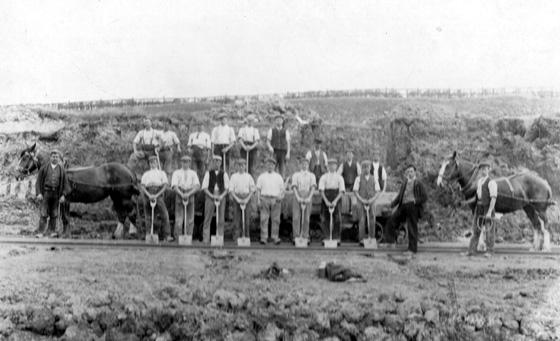
The men who built the railway, The Batters, Medbourne, 1880
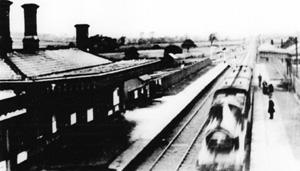
A train for Peterborough steams through Medbourne
The line opened for passenger traffic in 1883 passing through the newly-built Medbourne Station. The Station House, which still stands on the site, was the Station Master's accommodation. The old Medbourne station on Ashley Road was renamed "Ashley and Weston".
It is believed that the line was constructed for "political" reasons, as a result of the inter-company rivalry, rather than for any social or economic reasons.
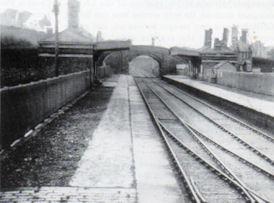
The station when it had a double track
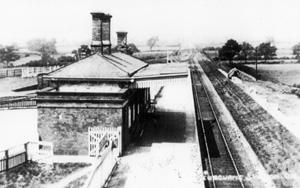
Later reduced to a single track
So, not surprisingly, the line was little used. It‘s likely that Medbourne villagers would have preferred Market Harborough as a destination. As a consequence, the line was reduced to a single track in 1905, (which dates the picture left to post 1905).
In 1916 the line was closed as a wartime economy. Sadly, shortly after closure, the station was accidentally burned down. After 1916 the line was only used for goods, and then mainly for storing wagons. In the 1960s the track was finally lifted.
After closure
Following the closure of the railway the Station House was occupied by a retired Station Master and, for many years, the yard was used as a coal depot. One particular character remembered by older villagers was “Speaker" Payne who, in the 1920s, ran a coal delivery service by horse and cart. Interestingly, he had a system whereby customers could pay for their coal by weekly subscriptions - a forerunner of today‘s Direct Debit!
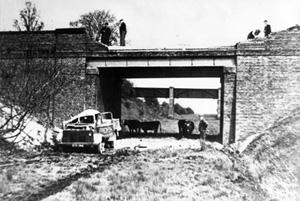
Accident on the Manor Road bridge
The station site eventually became a stables in 1992, a purpose it still serves today (2011).
The picture left shows a lime quarry lorry that has accidentally gone through the parapet on the Manor Road bridge and ended up on the trackbed. Behind the lorry you can see the Rectory Lane footbridge, known as the "Stamping Bridge". This is no longer there, as this area of the trackbed now hosts the housing development at the top of Old Holt Road.
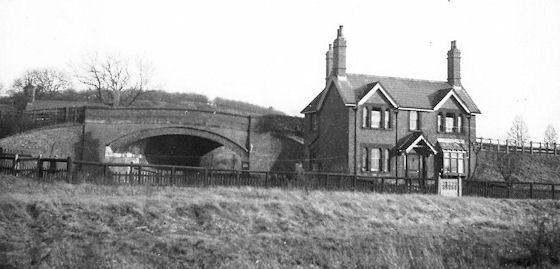
This postcard shows the Station Master's House and the road bridge carrying Uppingham Road, taken in 1939.
The Legacy
So what did Medbourne get from the railways? - thirty three years of passenger services to places of dubious value, followed by 95 years (and counting) of their industrial legacy. Thankfully, much of this has been reclaimed by nature.
Thanks are due to Mick Cooper and Keith Sandars for most of the information and photographs on this page. September 2011.
